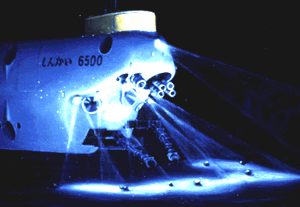
Exploring the deep ocean floor: Hot springs and strange creatures
The ocean floor is home to many unique communities of plants and animals.
Most of these marine ecosystems are near the water surface, such as the
Great Barrier Reef, a 2,000-km-long coral formation off the northeastern
coast of Australia. Coral reefs, like nearly all complex living communities,
depend on solar energy for growth (photosynthesis). The sun's energy,
however, penetrates at most only about 300 m below the surface of the water.
The relatively shallow penetration of solar energy and the sinking of cold,
subpolar water combine to make most of the deep ocean floor a frigid environment
with few life forms.
In 1977, scientists discovered hot springs at a depth of 2.5 km, on the
Galapagos Rift (spreading ridge) off the coast of Ecuador. This exciting
discovery was not really a surprise. Since the early 1970s, scientists had
predicted that hot springs (geothermal vents) should be found at
the active spreading centers along the mid-oceanic ridges, where magma,
at temperatures over 1,000 °C, presumably was being erupted to form
new oceanic crust. More exciting, because it was totally unexpected, was
the discovery of abundant and unusual sea life -- giant tube worms, huge
clams, and mussels -- that thrived around the hot springs.

View of the first high-temperature vent (380 °C) ever
seen by scientists during a dive of the deep-sea submersible Alvin
on the East Pacific Rise (latitude 21° north) in 1979. Such geothermal
vents--called smokers because they resemble chimneys--spew dark,
mineral-rich, fluids heated by contact with the newly formed, still-hot
oceanic crust. This photograph shows a black smoker, but smokers can also
be white, grey, or clear depending on the material being ejected. (Photograph
by Dudley Foster from RISE expedition, courtesy of William R. Normark, USGS.)
Since 1977, other hot springs and associated sea life have been found at
a number of sites along the mid-oceanic ridges, many on the East Pacific
Rise. The waters around these deep-ocean hot springs, which can be as hot
as 380 °C, are home to a unique ecosystem. Detailed studies have shown
that hydrogen sulfide-oxidizing bacteria, which live symbiotically with
the larger organisms, form the base of this ecosystem's food chain. The
hydrogen sulfide (H2S--the gas that smells like rotten eggs) needed by these
bacteria to live is contained in the volcanic gases that spew out of the
hot springs. Most of the sulfur comes from the Earth's interior; a small
portion (less than 15 percent) is produced by chemical reaction of the sulfate
(SO4) present in the sea water. Thus, the energy source that sustains this
deep-ocean ecosystem is not sunlight but rather the energy from chemical
reaction (chemosynthesis).
But the story about the source of life-sustaining energy in the deep sea
is still unfolding. In the late 1980s, scientists documented the existence
of a dim glow at some of the hot geothermal vents, which are the targets
of current intensive research. The occurrence of "natural" light
on the dark seafloor has great significance, because it implies that photosynthesis
may be possible at deep-sea geothermal vents. Thus, the base of the deep-sea
ecosystem's food chain may comprise both chemosynthetic and, probably
in small proportion, photosynthetic bacteria.
Scientists discovered the hot-springs ecosystems with the help of Alvin,
the world's first deep-sea submersible. Constructed in the early 1960s for
the U.S. Navy, Alvin is a three-person, self-propelling capsule-like
submarine nearly eight meters long. In 1975, scientists of Project FAMOUS
(French-American Mid-Ocean Undersea Study) used Alvin to dive on
a segment of the Mid-Atlantic Ridge in an attempt to make the first direct
observation of seafloor spreading. No hot springs were observed on this
expedition; it was during the next Alvin expedition, the one in 1977
to the Galapagos Rift, that the hot springs and strange creatures were discovered.
Since the advent of Alvin, other manned submersibles have been built
and used successfully to explore the deep ocean floor. Alvin has an operational
maximum depth of about 4,000 m, more than four times greater than that of
the deepest diving military submarine. Shinkai 6500, a Japanese research
submarine built in 1989, can work at depths down to 6,400 m. The United
States and Japan are developing research submersible systems that will be
able to explore the ocean floor's deepest spot: the 10,920-m Challenger
Deep at the southern end of the Marianas Trench off the Mariana Islands.

Sketch of the Shinkai 6500, a Japanese vessel that
is currently the world's deepest-diving manned research submarine. (Courtesy
of Japan Marine Science & Technology Center.)



 Bizarre sea life [45 k]
Bizarre sea life [45 k] Alvin collects
a giant clam [40 k]
Alvin collects
a giant clam [40 k] Giant clams [50 k]
Giant clams [50 k] USGS scientist enters
Alvin [70 k]
USGS scientist enters
Alvin [70 k] Alvin launch [50 k]
Alvin launch [50 k] Tube worm colony
[50 k]
Tube worm colony
[50 k] Spider crab [55 k]
Spider crab [55 k]